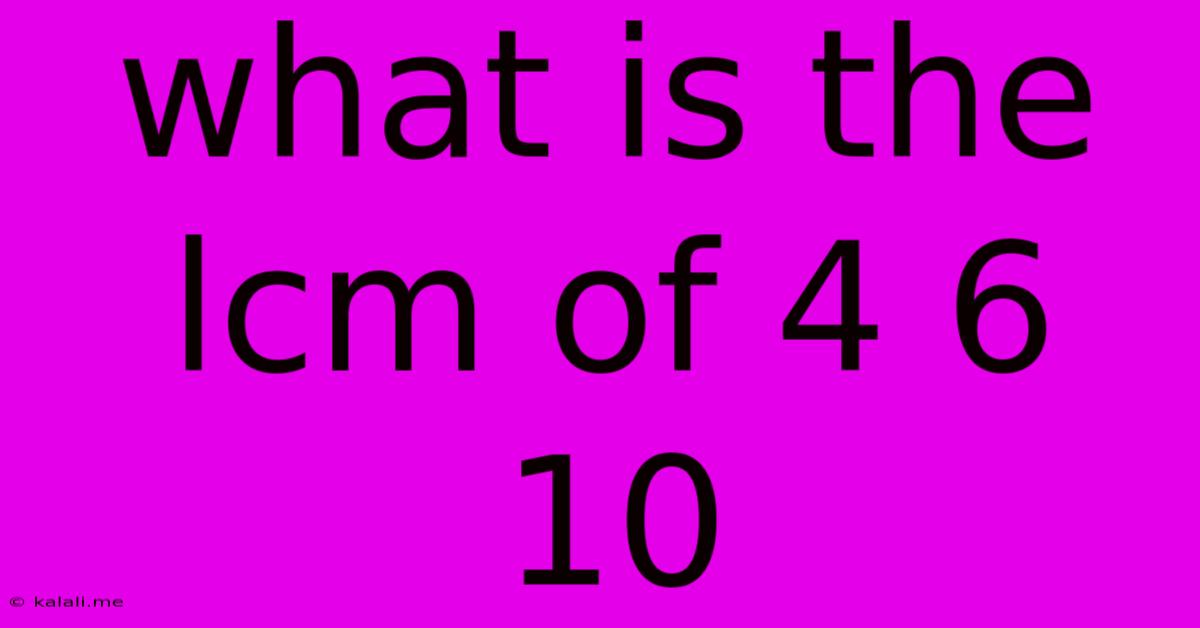What Is The Lcm Of 4 6 10
Kalali
Jun 14, 2025 · 2 min read

Table of Contents
What is the LCM of 4, 6, and 10? A Step-by-Step Guide to Finding the Least Common Multiple
Finding the least common multiple (LCM) is a fundamental concept in mathematics, particularly useful in simplifying fractions and solving problems involving ratios and proportions. This article will guide you through a step-by-step process to calculate the LCM of 4, 6, and 10, and explain the underlying principles. Understanding how to calculate the LCM is crucial for various mathematical applications and improves your overall number sense.
What is the Least Common Multiple (LCM)?
The least common multiple (LCM) of two or more numbers is the smallest positive integer that is divisible by all the numbers. In simpler terms, it's the smallest number that all the given numbers can divide into evenly. For instance, if you're working with fractions and need a common denominator, the LCM is your solution.
Methods for Finding the LCM of 4, 6, and 10
There are two primary methods to determine the LCM: the listing method and the prime factorization method. Let's explore both to find the LCM of 4, 6, and 10.
1. Listing Method:
This method involves listing the multiples of each number until you find the smallest multiple common to all.
- Multiples of 4: 4, 8, 12, 16, 20, 24, 28, 30, 32, 36, 40...
- Multiples of 6: 6, 12, 18, 24, 30, 36, 42, 48, 54, 60...
- Multiples of 10: 10, 20, 30, 40, 50, 60, 70, 80, 90, 100...
By comparing the lists, we can see that the smallest common multiple is 60. Therefore, the LCM of 4, 6, and 10 is 60. While this method works well for smaller numbers, it becomes less efficient for larger numbers.
2. Prime Factorization Method:
This method is more efficient, especially when dealing with larger numbers. It involves breaking down each number into its prime factors.
- Prime factorization of 4: 2 x 2 = 2²
- Prime factorization of 6: 2 x 3
- Prime factorization of 10: 2 x 5
Now, we identify the highest power of each prime factor present in the factorizations:
- The highest power of 2 is 2² = 4
- The highest power of 3 is 3¹ = 3
- The highest power of 5 is 5¹ = 5
To find the LCM, we multiply these highest powers together: 4 x 3 x 5 = 60
Therefore, using the prime factorization method, we again find that the LCM of 4, 6, and 10 is 60.
Conclusion:
Both methods effectively determine the LCM of 4, 6, and 10, resulting in the answer 60. The prime factorization method is generally preferred for its efficiency, especially when dealing with larger numbers or a greater number of integers. Understanding both methods provides a versatile approach to solving LCM problems across various mathematical contexts. Remember that mastering LCM calculations is essential for a strong foundation in mathematics and its related applications.
Latest Posts
Latest Posts
-
Which Of The Following Is True About Fungi
Jun 14, 2025
-
Lcm Of 6 7 And 8
Jun 14, 2025
-
Choose The Sentence With Correct Punctuation
Jun 14, 2025
-
Kinetic Energy Of Simple Harmonic Motion
Jun 14, 2025
-
What Day Will It Be In 61 Days
Jun 14, 2025
Related Post
Thank you for visiting our website which covers about What Is The Lcm Of 4 6 10 . We hope the information provided has been useful to you. Feel free to contact us if you have any questions or need further assistance. See you next time and don't miss to bookmark.